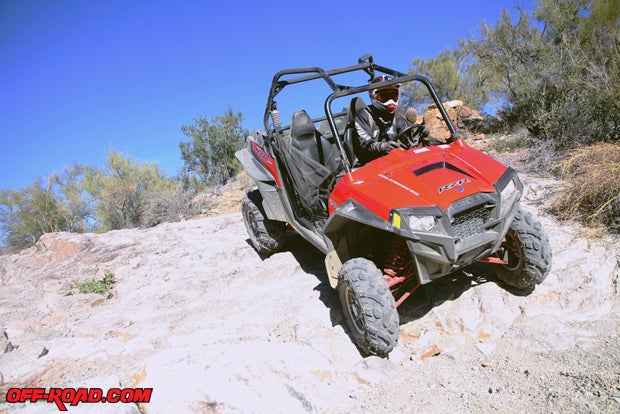
Forget everything you thought you knew about sport-oriented side-by-sides. The new Polaris Ranger RZR XP 900 has just re-written the book and taken the industry in a brand new direction. We recently had a chance to test out the new beast and were absolutely blown away by the experience.
To be perfectly honest, when Polaris first informed us it was introducing a new RZR we initially thought we’d be seeing little more than a bigger engine thrown in the RZR S chassis – a quick response to the Can-Am Commander. We couldn’t have been more wrong.
Instead of just tweaking the already impressive RZR S and playing follow the leader with the other manufacturers, Polaris decided to play a whole new game. While the rest of the industry produces versatile sport-utility side-by-sides to try and appeal to everybody, the RZR XP throws away any notion of utility. It may not be able to haul heavy loads around a worksite, but the RZR XP can haul ass like nothing we’ve ever seen. It may only appeal to a select group, but when it comes to pure sport performance the RZR XP is in a league of its own.
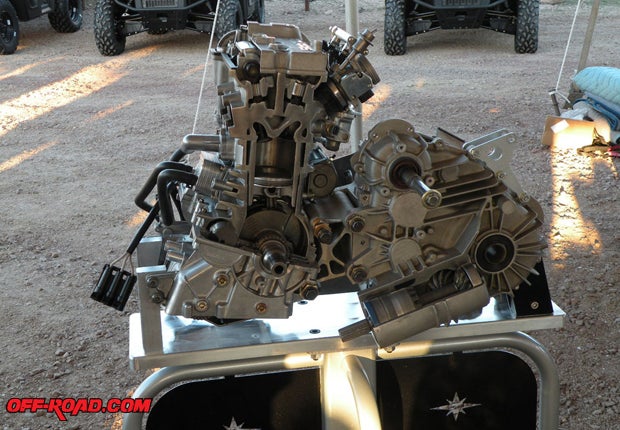
Powerplant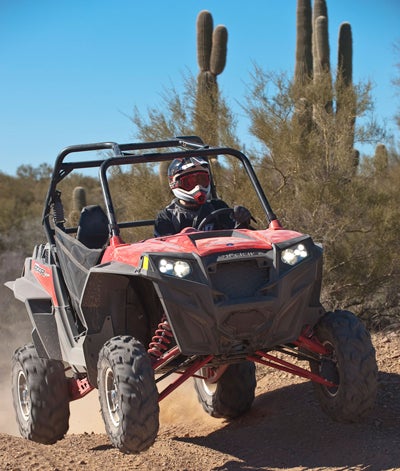 The RZR XP gets its growl from a brand new engine – the ProStar 900. While the 850cc mill from the Sportsman XP family seemed like a logical choice, Polaris decided to build the first engine ever designed specifically for a side-by-side.
The RZR XP gets its growl from a brand new engine – the ProStar 900. While the 850cc mill from the Sportsman XP family seemed like a logical choice, Polaris decided to build the first engine ever designed specifically for a side-by-side.
Producing an incredible 88 horsepower at the crank, the ProStar 900 is an 875cc, 4-stroke, fuel injected, DOHC Twin cylinder engine. This powerhouse revs about 2000 rpm higher than the other RZR engines with a redline over 8000 rpm. It’s higher pitched than the rest of the RZR family – not exactly like a sport motorcycle, but certainly moving in that direction.
Polaris knew the ProStar 900 could produce plenty of power, but getting as much of that power to the ground was paramount. The solution was to mount the engine transversely so the crankshaft was positioned side-to-side instead of front-to-back. This ensures that it’s rotating in the same direction as the rear wheels. As Polaris explains it, this is a very efficient way to transfer power to the ground because you’re not losing power through right-angle drives.
Polaris also redesigned the front drive, making it more durable to match the power output of the engine. Changes include a higher oil volume in the front gear case and a larger bearing – changes also made to the entire RZR family for 2011. The RZR XP takes things to another level, including adding a billet aluminum cage for maximum durability.
A more robust engine doesn’t mean much if it can’t breathe, so Polaris outfitted the RZR XP with a much bigger air filter – 90 percent more surface area than the original RZR. Helping to cool all that air is a new larger radiator.
Put it all together and you’ve got acceleration like we’ve never experienced in a side-by-side and a top speed of 73 mph.
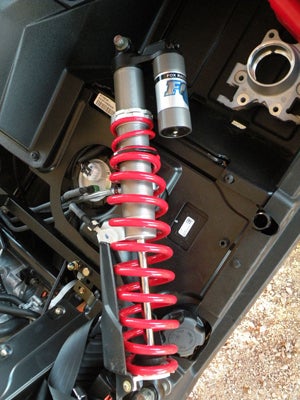 Suspension & Chassis
Suspension & Chassis
Wanting to best match the increased power to the suspension, Polaris decided to scrap its renowned dual A-arm design. In its place is a new 3-Link Trailing Arm system that borrows heavily from high-powered trophy trucks.
According to Polaris, the idea was to get the most suspension travel possible while optimizing the geometry. The 3-Link Trailing Arm system provides a ridiculous 14 inches of travel while maintaining 13 inches of ground clearance. By mounting the long trailing arms up forward in the chassis and using long radius rods Polaris managed to spread out the mounting points and transfer the load from the rear wheels directly up into the frame – the strongest part of the vehicle.
As the wheels for through the 14 inches of suspension travel the scrub is minimized, but you still get some camber change so when you go into the corner the meat of the tires is still on the trail. This offers the rider a more sure-footed feel.
Up front Polaris uses its tried-and-true dual-Arm design as found on the rest of the RZR family, which provide 13.5 inches of travel. Two-inch Fox Podium X 2.0 piggyback reservoir shocks with preload and compression adjustability are found at all four corners.
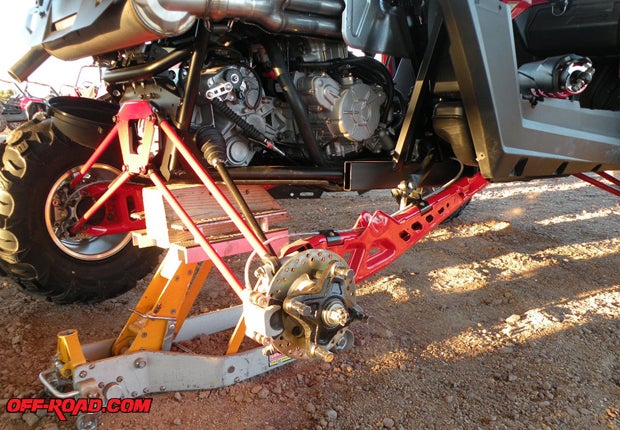
Handling is further benefited by a wider footprint and longer wheelbase. The RZR XP sits 3.5 inches wider than the RZR S and RZR 4 at 64 inches. That may not be ideal for tight woods riding, but in the desert and more open terrain it can feel like you’re riding on rails. The wheelbase has been stretched to 81.4 inches and that allows you to attack trail chop and whoops more aggressively.
Other Touches
You may not think much about lighting, but Polaris does. The RZR XP comes outfitted with LED headlights. Polaris says these lights mimic the light from the sun. We didn’t get a chance to run in the dark so we can’t attest to how they perform when the sun goes down, but when Polaris turned them on in the middle of the day we had to shield our eyes – we actually got sun spots. Hopefully that means you’ll be able to see what’s coming if you like to ride at night.
Easy maintenance was also top of mind for Polaris when designing the RZR XP. You can access the spark plugs and filter under a panel in the cargo box. Another positive is that you can now change the oil without removing the seats.
Riding Impressions
It’s easy to get charmed when you go to a new vehicle intro. Not only is the machine something you’ve never ridden, but the location is usually new and the marketing types pile on the hype. It can be tough to stay composed and open-minded. In the case of the RZR XP, however, the machine was even better than advertised.
As soon as we stepped out of the RZR XP all we wanted to do was get right back in. We didn’t want our test session to end. If it weren’t for an overwhelming fear of being incarcerated we probably would have driven it home and called it our own.
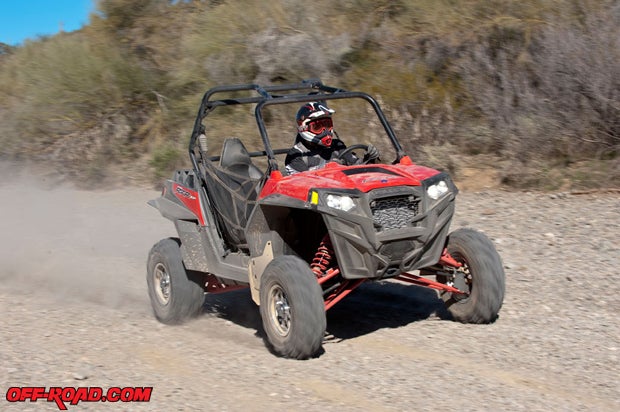
Engine performance was outstanding. One push of the throttle and you experience acceleration like no other side-by-side. The RZR S is a very fast machine in its own right, but it just doesn’t compare to the RZR XP. We rode both on the same day and the difference is shocking.
While we were playing around in the Arizona desert all day, the circuit we were riding was mostly made up of deep whoops and tight corners. We did encounter some open areas, but we never did open the engine up entirely. The speedometer read well over 60 mph multiple times, but we never had the opportunity to fully stretch the RZR XP’s legs and reach the claimed top speed of 73 mph. That being said, we’ve got no doubt it will get there.
All of Polaris’ suspension work made a massive impression in the whoops. We were part of the second wave of media testing out the RZR XP so the route Polaris mapped out was seriously whooped out by the time we got to it. After somewhat tentatively riding through the whoops in the early going, we got more and more aggressive as the day progressed. By the end of the day we were in all-out attack mode. No matter how hard we came into the whoops, we did not once bottom out and stayed on course all day. It almost felt like we were riding on top of the whoops rather than through them. Surely the longer wheelbase contributed to that. On the rare occasions where it felt like we might be in trouble and out of control, the RZR XP was able to right itself. It makes you feel like a better rider than you actually are.
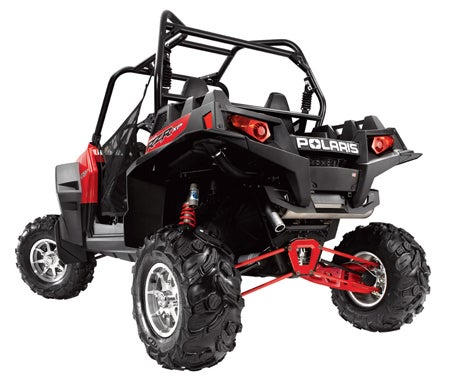 Cornering was also a little different than anything we’d previously experienced. While the original RZR and RZR S are adept at sliding around corners, we found the back end of the RZR XP grabbed on a little more. It feels a little less playful in that regard, but we think speed coming out of the corners is probably a little better because when you press down on the throttle the tires are already hooked up. We’d like more seat time to explore this further.
Cornering was also a little different than anything we’d previously experienced. While the original RZR and RZR S are adept at sliding around corners, we found the back end of the RZR XP grabbed on a little more. It feels a little less playful in that regard, but we think speed coming out of the corners is probably a little better because when you press down on the throttle the tires are already hooked up. We’d like more seat time to explore this further.
Though we didn’t spend much time playing around on the big rocks, the RZR XP did prove a proficient climber. We spent some time rock crawling and were impressed at how well it handled everything. We really just had to point in the right direction and mash the throttle to power up and over everything in our path.
One minor criticism, if you can call it that, is with the steering. When we first stepped into the cockpit we found the steering to be quite heavy. It may actually be better for handling because you can feel so much of the trail through the steering wheel, but it also tires your arms out a little quicker than you’d expect. Don’t be surprised to see power steering make its way to the RZR XP in the near future.
Conclusion
Polaris is well aware that the Ranger RZR XP 900 isn’t for everybody, but for anyone looking for pure sport performance it has no equal. The price tag ($15,999) may be a deterrent to some, but to transform a RZR S or any other side-by-side into a performer like this would be near impossible without spending thousands more.


 Your Privacy Choices
Your Privacy Choices